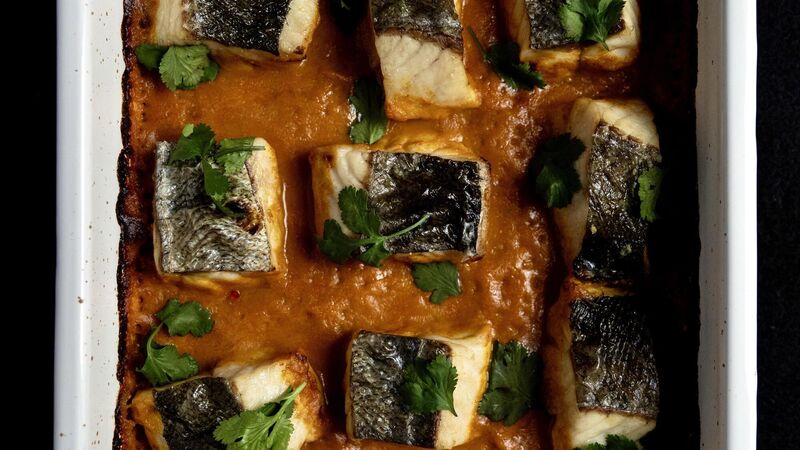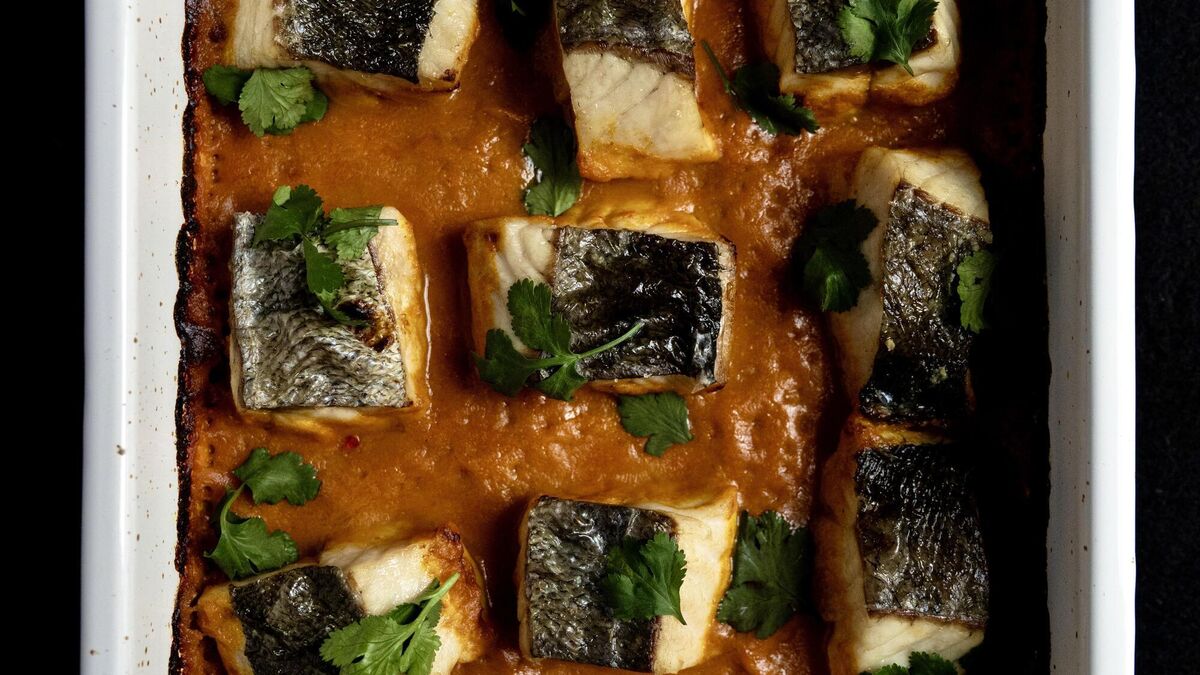Seafood Made Simple: Spice up fresh fish with this tomato masala

Baked pollock & tomato masala. Picture: Chani Anderson
I’ve been collecting cookbooks since I was a teenager. The iconic by Jamie Oliver was my favourite at the time.
Since then, I have accumulated hundreds, many of which unfortunately I haven’t had the chance to get stuck into yet.
When we opened Goldie, I convinced my fabulous business partners that it would be a good idea to use my personal library as part of our decor. So, we put up shelving anywhere we could.
A functional addition to our building, we use them as reference points everyday when we are constructing our menu, and as inspiration when we have a glut of a particular vegetable or species of fish.
I love sending the team home with stacks of books for the weekend and every now and then a guest might borrow a copy.
Thanks to Kristen Jensen, publisher of Blasta Books, my book sits proudly on the shelf amongst many of my heroes, like Fergus Henderson and Myrtle Allen.
When covid came along it gave me the opportunity to cook from so many of the books that I’d shelved, like recipes from Fuschia Dunlop’s . A brilliant cookbook for those who want to learn more about Sichuan cuisine, her dan-dan noodle recipe in that book is more than worth the trip to your local Asian supermarket with a very extensive shopping list.
I spent a lot of time making Indian food too, as it was getting the best reaction from my household for the parathas, chutneys and masalas.
Cooking from the by Pushpesh Panti really informed my cooking.
Published by Phaidon, it’s a mammoth book of 1,000 recipes, so it’s a lot of bang for your buck, and one I recommend to anyone who tells me they love Indian food.
Baked pollock with tomato masala
This recipe works so well with the flaky texture of pollock, a fish we don’t tend to eat a whole lot of in this country — but you could use just about any fish in this recipe.

Servings
4Preparation Time
30 minsCooking Time
27 minsTotal Time
57 minsCourse
MainIngredients
3 tbsp rapeseed oil
1 thumb of ginger ,diced
2 tbsp green chilli, sliced
1 onion, diced
1 tsp kashmiri chilli powder
2 tsp ground coriander
1/2 tsp ground turmeric
1 tsp garam masala
80g tomatoes, chopped
1 lemon
For the pollock:
450g pollock, skin-on, cut into chunks
1 tbsp rapeseed oil
Sea salt flakes
1 bunch fresh coriander, to serve
Method
To make the masala sauce:
Heat the oil in a heavy-based medium pot and cook the ginger and chilli over a medium-low heat for 2 minutes.
Add the onion and cook for approximately 4 minutes until softened.
Add all the spices. Cook for 2 minutes, being careful not to allow them to burn.
Next add the chopped tomatoes, season with a little salt and cook for 5 minutes until they begin to break down.
Transfer the mixture to a food processor or blend using a handheld blender until puréed.
Finish the sauce with the juice of a lemon and season to taste with salt.
To cook the fish. remove the pollock from the fridge 10 minutes before cooking.
Pat dry to remove any excess moisture.
Preheat the oven to 195°C.
Place the tomato masala sauce in an 8.5 x 11.5-inch oven dish.
Lay the chunks of pollock skin-side-up in the tomato masala. Make sure to leave a little space between each piece to allow the heat to circulate.
Brush the chunks of fish with rapeseed oil and season with sea salt flakes.
Bake in the oven for 7 minutes. Turn the oven up to 210°C and bake for a further 4-5 minutes, until cooked through and flaking when pressed with a spoon.
Garnish with fresh coriander and serve with some steamed basmati and naan.
- This tomato masala can be made ahead of time. Warm the sauce before placing in the oven dish to speed up the cooking time.
- If you are sensitive to heat, you can reduce or remove the chillies from this recipe.
- The sauce is great for batch cooking. It keeps in the fridge for 3 days and freezes well.
- Kashmiri chilli powder is a wonderful addition to any spice rack, milder than most chilli powders available.
- I like to keep the skin on when baking fish, especially with pollock as its skin crisps wonderfully. If you’d rather not eat the skin, it will peel off easily once cooked.
- This recipe works so well with the flaky texture of pollock, a fish we don’t tend to eat a whole lot of in this country — but you could use just about any fish in this recipe. I’d recommend ling too but use whatever’s fresh and available at your local fishmonger's.





